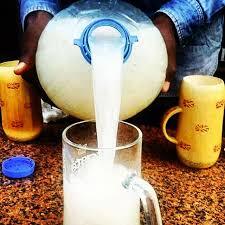Production of a probiotic drink made from raffia sap / Production d’une boisson probiotique à base de sève de Raphia (2018)

In order to contribute to the diversification of the range of probiotic products limited until now to the dairy matrices and to valorize the local raw materials, we set ourselves the objective of finding the conditions of fermentation of the fresh sap of Rafia farinifera by two probiotic ferments namely L. fermentum and B. bifidum. We first characterized raffia sap physicochemically and studied the ability of ferments and their viability in the sap. The physicochemical characteristics of the sap (3.801% ± 0.037 dry matter, 7.044 ± 0.172 g of ash per 100 g of dry matter, 10.789 ± 1.388 g of reducing sugars per liter, titratable acidity of 4.44 equivalent grams of lactic acid per liter, pH of 4.12, 2.91 ± 0.94 g of total phenol compounds per liter, density of 1.158 g / L and a Brix of 4.2) and the viability of the ferments in the latter showed the feasibility of this work. Moreover, the optimization of physicochemical parameters thanks to the Box-Behnken model after maximizing Brix, reducing sugars and proteins and setting the pH at 4, lactic acidity at 9 g / L, the amount of probiotics at 1,00 E+10CFU / mL, as well as the inhibition diameters at 14 mm for Salmonella sp and 12 mm for the other 3 strains tested (L. monocytogenes, E. coli and B.cereus) led to the following operating conditions: B.bifidum and L. fermentum seeding rates of 10% and 2.82% respectively, an incubation temperature of 37 ° C and an incubation time of 14 H 2 min. Thus, these conditions made it possible to obtain a drink having a titratable acidity of 8 g of lactic acid / L, a pH of 3.87, a protein content of 574.6 (mg / L), a Brix of 5 ,47 and an amount of probiotics of 1.13 E + 8 CFU / mL. Beyond this optimization, a sensory analyse performed on the optimized product showed that it was organoleptically acceptable.
Probiotics à base de sève de raphia_compressed.pdf
French
Dans l’optique de contribuer à la diversification de la gamme des produits probiotiques limités jusqu’ici aux matrices laitières et de valoriser les matières premières locales, l’objectif de trouver les conditions de fermentation de la sève fraiche de Rafia farinifera par deux ferments probiotiques à savoir L. fermentum et B. bifidum a été fixé. La caractérisation de la sève de raphia a été réalisée et les valeurs suivantes ont été obtenues : 3,801 % ± 0,037 de matière sèche, 7,044 ± 0,172 g de cendres par 100 g de matière sèche, 10,789 ± 1,388 g de sucres réducteurs par litre, acidité titrable de 4,44 équivalent gramme d’acide lactique par litre , pH de 4,12, 2,91 ± 0,94 g de composés phénoliques totaux par litre, masse volumique de 1,158 g/L et un Brix de 4,2. Le suivi de la viabilité des ferments dans cette sève ont montré une évolution de celle-ci traduisant la possibilité de fermenter cette sève avec les deux souches. Par ailleurs, l’optimisation des paramètres physicochimiques grâce au modèle de Box-Behnken après avoir maximisé le Brix, les sucres réducteurs et les protéines et fixé le pH à 4, l’acidité lactique à 9 g/L, la quantité de probiotiques à 1,00 E+10 UFC/mL, ainsi que les diamètres d’inhibition à 14 mm pour Salmonella et 12 mm pour les 3 autres souches testées (L.monocytogenes, E.coli et B.cereus) a conduit aux conditions opératoires suivantes : des taux d’ensemencement de B.bifidum et L.fermentum respectifs de 10 % et 2,82 % , une température d’incubation de 37 °C et un temps d’incubation de 14 h. Ainsi, ces conditions ont permis d’obtenir une boisson ayant une acidité titrable de 8 g d’acide lactique/L, un pH de 3,87, une teneur en protéines de 574,6 mg/L, un Brix de 5,47 et une quantité de probiotiques de 1,13*10+8 UFC/mL. Au-delà de cette optimisation, une analyse sensorielle réalisée sur le produit optimisé a montré que celui-ci était acceptable sur le plan organoleptique.


